Artists' Writing
Artists' Writing
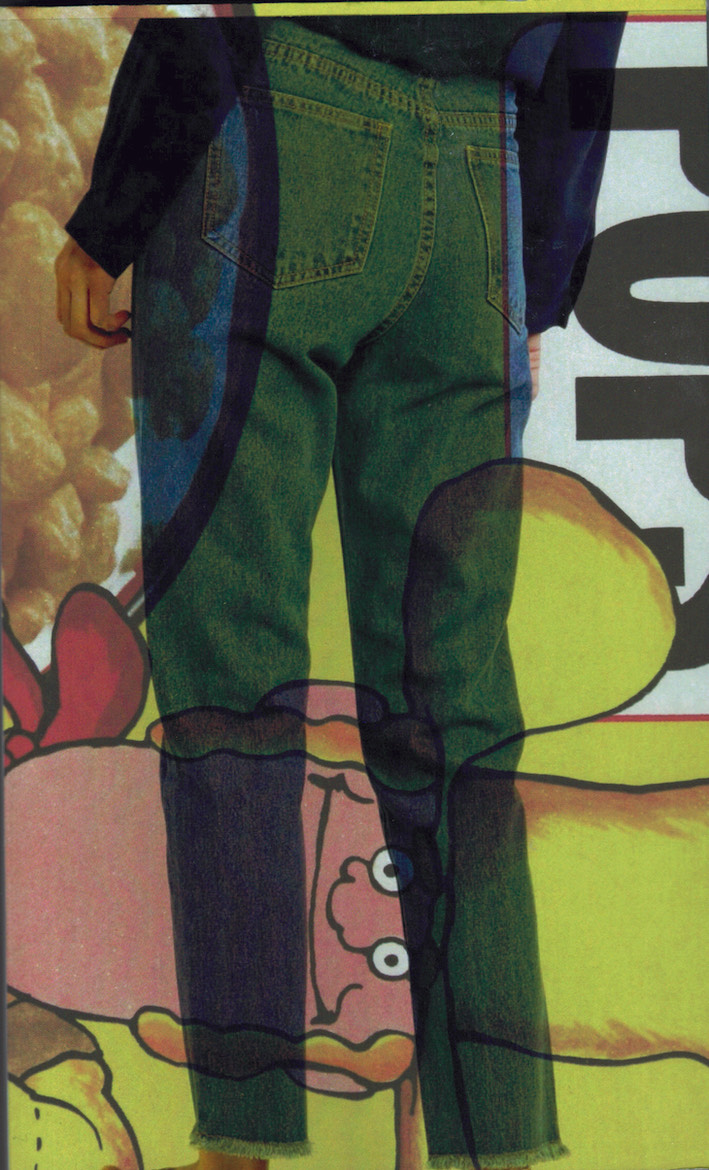
Homophone Dictionary
Homophone Dictionary was originally a file that is compiled by the now 96-year-old former schoolteacher Susan Nixon. She has build up many collections throughout her life, almost all of them exist out of objects, except one: after her retirement she compiled a word document that by now exist out of almost 1000 homophones; two, or more words that you pronounce similar but have a different meaning, often the spelling is also different.
The document is structured as a dictionary and the homophones are illustrated with examples that are based on autobiographical information. The structure of Homophone Dictionary also refers to speech therapy exercises and concrete poetry.
“As a student nurse learning medical terminology, I became fascinated with understanding the roots of words. When I had a young family, words were a principal source of entertainment: it was not unusual for one of the children to slip from their chair at the dinner table and fetch a dictionary in order to settle a dispute or satisfy someone’s curiosity. Then I became a teacher and brought this love of words into the classroom. My habit of word collecting became the children’s habit – my pupils became ‘word-lovers’ and ‘list-makers.’
I casually collected homophones for years. When introducing homophones into the classroom, the kids found definitions dull; the typical reaction was, ‘Yes, but give me a sentence using the word!’ and this idea emerged: a book of sentences demonstrating the meanings of homophone pairs or sets.”
Author Sue Nixon, editor Riet Wijnen, Offset print
20,4 × 12,4 cm, 423 pages
edition of 500
Published 2020

one long continuous line or a thought that dissolves into the distance
A short text or a long line written by Mette Edvardsen for Etcetera magazine (June 2018) on an invitation to elaborate on her approach to text, writing and speech from a choreographic point of view. Held by a cardboard cover, the text is here published on its own as a very slim book.

Moments Before The Wind
Moments Before the Wind is a heterogeneous collection of notes on scenography that offers a glimpse into the poetics and artistic practice of Jozef Wouters. These reflections on space, scenography, art making and institutional critique have developed over the years as they were written out loud in various contexts. Now settling on the page among built and unbuilt spaces, they’re an invitation to the reader to think along or against, and think up space for oneself. Edited by Jeroen Peeters; graphic design by Filiep Tacq.
Jozef Wouters is a scenographer and theatre maker based in Brussels, who develops work in collaboration with his Decoratelier. Decoratelier is also a workplace for set designers and artists, and provides room for cross-disciplinary ventures and social experiment.

Off by Heart
Between 2014 and 2016, the artist Wendy Morris started off on different walks along the west coast of Europe, following the path of a family of Huguenots during the repression after the Edicts of Nantes at the end of the 17th century. Throughout her walks, Morris drew new maps and routes of the places visited by the Huguenot refugees, who just as today passed through Calais and Dunkerque in France, moving on to Blankenberge, Zeebrugge and then Vlissingen as their final destination in the Netherlands. Then and now again, these ports and places were known as escape routes towards a better future.
It is their experiences that Morris tries to elucidate via carefully selected texts fragments, recited psalms and testimonies that are juxtaposed with official publications and regulations dictated by the Catholic Church against these Huguenots. The artist also mapped her own route while simultaneously making notes and collecting samples of grass, trees, seeds, plants, and the like, which may have been used by the refugees to heal the daily injuries caused by the long trip.

The Imaginary Republic
The Imaginary Republic is an artistic research project focusing on questions of social practice. In particular, it considers the creative and restless imaginaries underpinning our political selves and argues for a deeper engagement with what Elena Loizidou terms “dream-action”: the figurative and poetic staging of world making activity.
The publication brings together participating artists Tatiana Fiodorova, Octavio Camargo / Brandon LaBelle, the Sala-Manca Group, and Joulia Strauss, whose practices engage situations of struggle and autonomous cultures through a range of methods and approaches. From social fictioning to camouflaged interventions, collaborative pedagogies to gestures of care, their works propose unlikely paths of mutuality. The publication includes documentation of an exhibition held at Kunsthall 3,14 in Bergen, as well as key essays and works by theorists and artists Rhiannon Firth, Hélène Frichot, Marysia Lewandowska, Gerald Raunig, Raimar Stange with Oliver Ressler, and Manuela Zechner.
published in June 2020
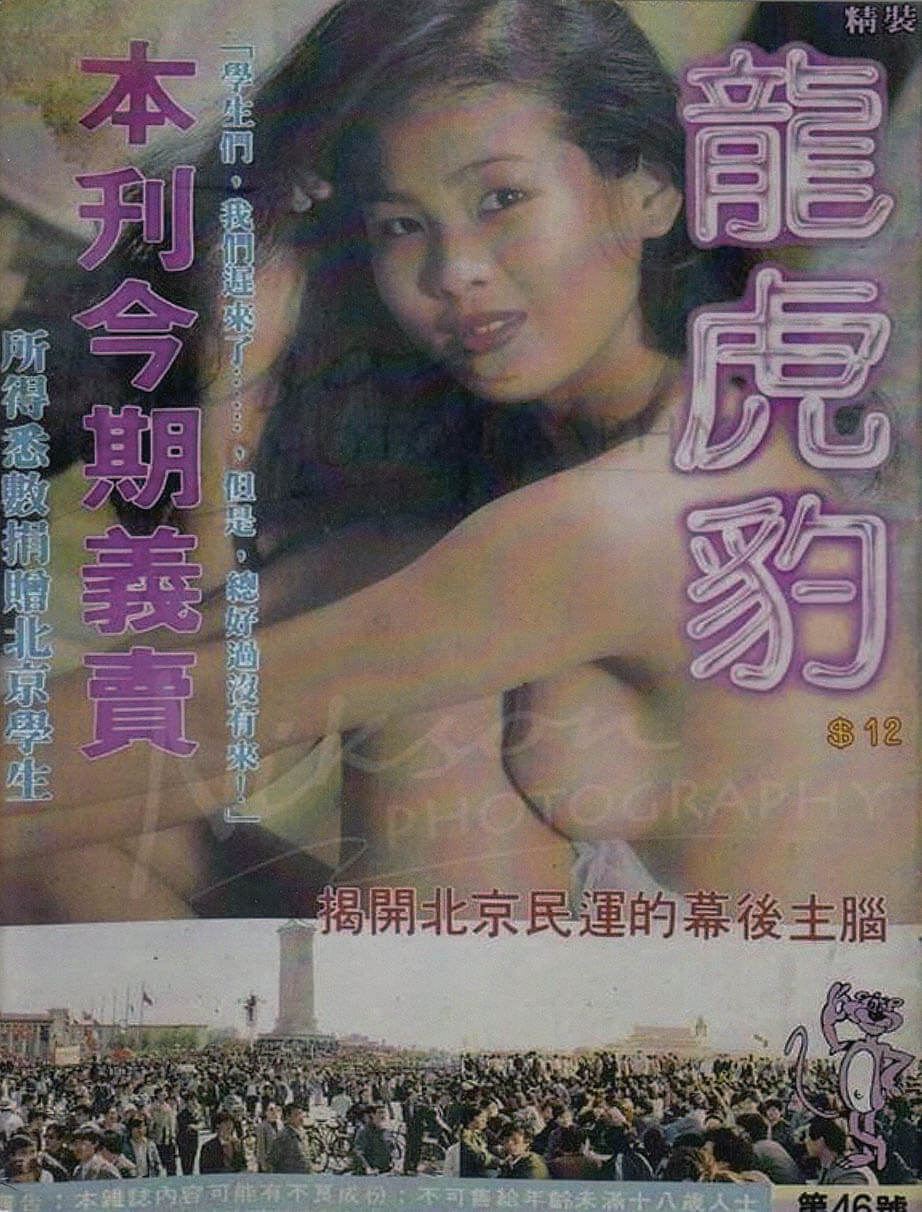
(Salty Wet)
咸濕 (Salty Wet) - an anti-travelogue essay on distance and desire within and without Hong Kong
“There is no Hong Kong anymore.” These four words have been on the lips of my colleagues, friends and family. Even if you have never been, every Chinatown is a facsimile of Hong Kong. The city’s specter also lives in pop culture, movies and cantopop and video games, and in these projections, we live its simulacrum. In history, dead cities have their morbid enigma and mythology from Pompeii to Rome. But if I could find coherence in living through political decay, outside of the frameworks of news journalism or historiography, then perhaps I would be able to find a more human way to mourn Hong Kong."
T▇▇ 謝▇ is an independent film producer based between Hong Kong and New York and the founder of Speculative Place. She was the Executive Producer of Adam Khalil and Bayley Sweitzer’s feature debut film Empty Metal, and the forthcoming documentary film, Ancestors in the Archives, directed by Adam and Zack Khalil. 謝 is pronounced SHä (as in Shanghainese).
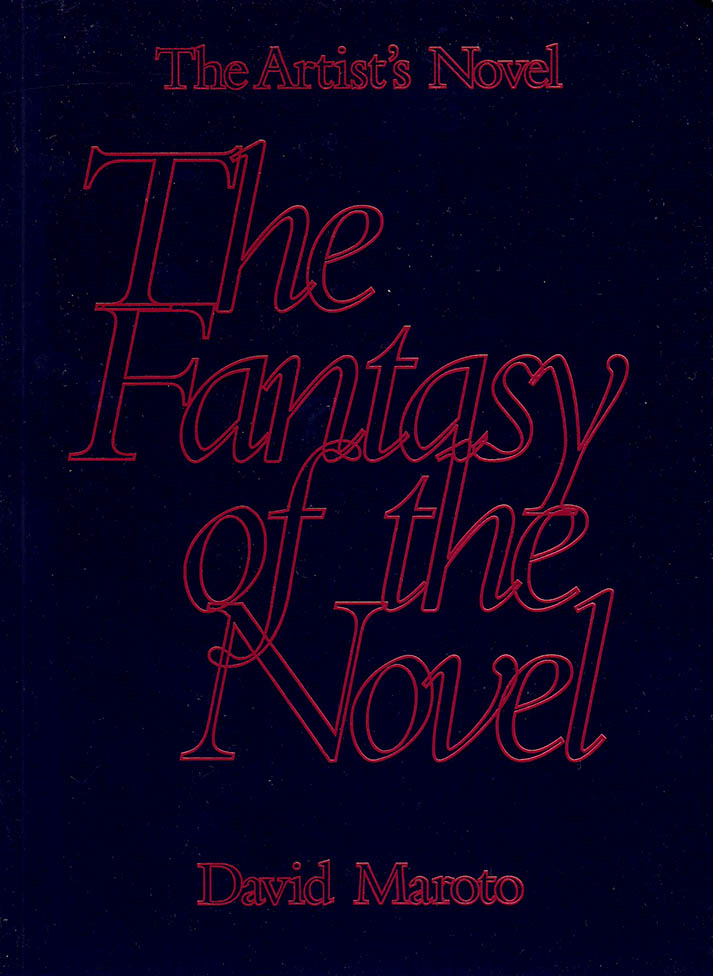
The Fantasy of the Novel
Second volume of a publication dedicated to the artist's novel, this metafiction follows a detective investigating the conditions of production of a novel within an artistic framework.
Why do artists write novels? What impact does the artist's novel have on the visual arts? How should such a novel be experienced? In recent years, there has been a proliferation of visual artists who create novels as part of their broader art practice. They do so in order to address artistic issues by means of novelistic devices, favoring a sort of art predicated on process and subjectivity, introducing notions such as fiction, narrative, and imagination. In this sense, it is possible to see the novel as a new medium in the visual arts; yet very little is known about it. This two-volume publication is the first to explore in depth the subject of the artist's novel.
The Fantasy of the Novel, is a research project in the form of a novel; it examines the process of creating an artist's novel derived from five episodic performances and an exhibition. The creative process was affected by the circumstances of production, including intersubjective relationships usually invisible to audiences. The protagonist assumes the role of a detective who tries to understand the conditions under which an artist decides to write, and how this writing is possible within an artistic setting.
David Maroto (born 1976, lives and works in Rotterdam) is a Spanish visual artist, researcher, writer, and curator. He is the co-curator of The Book Lovers, a research project on the artist's novel, together with Joanna Zielińska.
Published 2020

The Other Citizen
Drawing upon traditions of socially engaged poetics, Brandon LaBelle's The Other Citizen presents narratives of contemporary crisis and exclusionary politics—from American teenagers in the maze of neoliberal privatization to those caught between borders of nation-states—outlining the force of a planetary citizenry.
Brandon LaBelle is a musician, artist, writer, theorist, curator and editor (founder of Errant Bodies). His work is based on performance, sound installation, recording and use of found sounds. LaBelle reflects fluently on his artistic practice, drawing attention to the social dimensions of listening and manner in which sounds, in multiple variations, play upon public spaces, and drawing connections across media and incorporate video, as well as architectural and sculptural vocabularies into an expanded field that embraces rhetorical and spatial challenges.
Published September 2020.

The Nomadic Listener
Based on the author's artistic research on migration, contemporary urban experience, and sonic alienation, The Nomadic Listener is composed of a series of texts stemming from psychogeographic explorations of contemporary cities, including Copenhagen, Berlin, Kolkata, Vienna, Delhi, Hong Kong, Mumbai, and New York, among others.
Each text is an act of listening, where the author records his surrounding environment and attunes to the sonic fluctuations of movement and the passing of events. What surfaces is a collection of meditations on the occurrences of life movingly interwoven with memories, associations, desires and reflections. As readers we are brought into a tender map of contemporary urban experience, and the often lonely, surprising, and random interactions found in traveling. The Nomadic Listener includes parallel drawings based on the original audio recordings, and appear as ghostly renderings of the corresponding experiences. The recordings are published by Gruenrekorder and accessed through a QR code included in the book.
Budhaditya Chattopadhyay is a contemporary artist, researcher, writer and theorist. Incorporating diverse media, such as sound and moving image, Chattopadhyay produces works for large-scale installation and live performance addressing urgent issues such as the climate crisis, human intervention in the environment and ecology, migration, race, and decolonization.
published September 2020.
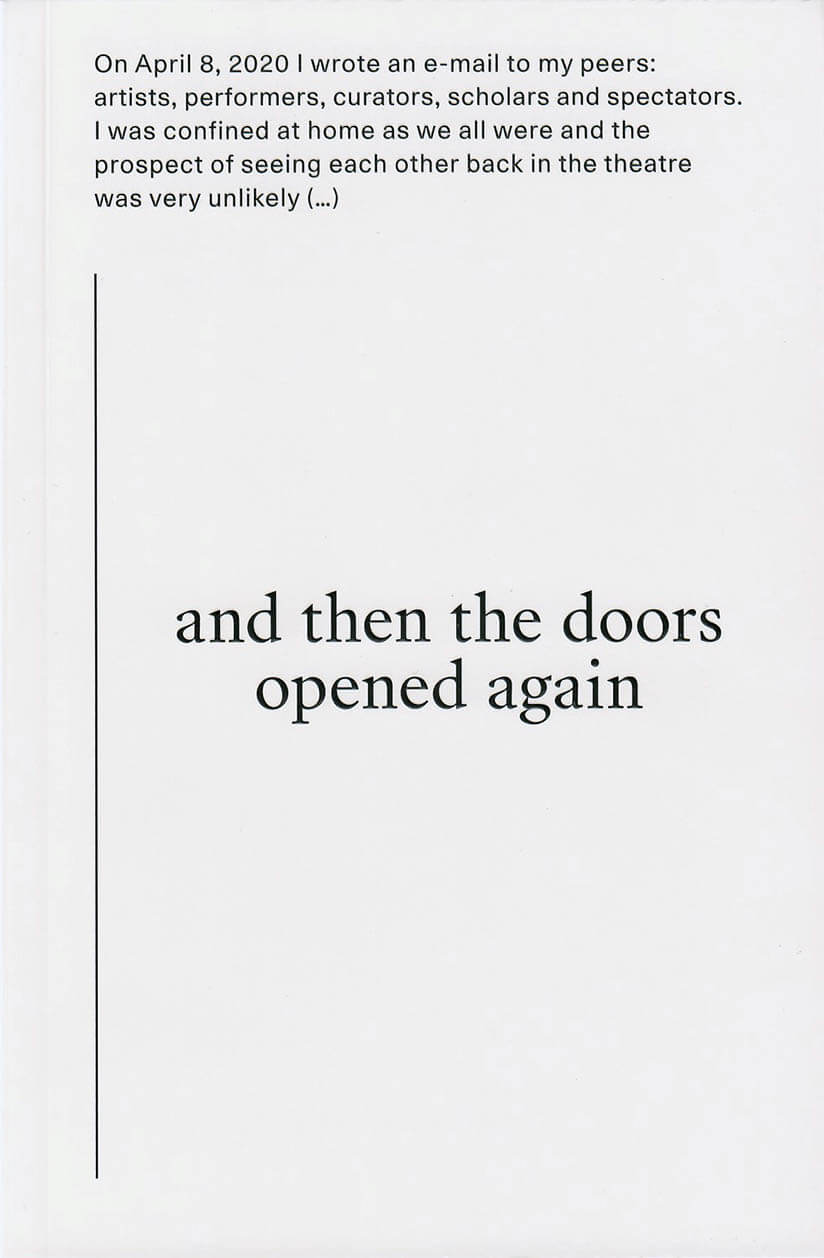
and then the doors opened again
Locked down at home during the first wave of Covid-19, David Weber-Krebs kept on thinking about the day when theatres would open their doors again. At that point, it was somehow difficult to even picture that moment.
On the 8th of April, 2020, in the middle of the lockdown, David sent an e-mail to his peers: artists, scholars, curators, and spectators belonging to different art communities. In this e-mail, there was a simple question: What will happen on your first theatre visit after the lockdown?
It was an invitation to imagine the future of theatre from this very specific moment when theatres were all closed and when it was not clear how and when and if they would open again.
With contributions by: Paula Almiron, Kristof van Baarle, Sven Age Birkeland, Antonia Baehr, Caroline Barneaud, Nicole Beutler, Maaike Bleeker, Julien Bruneau, Pieter De Buysser, Alondra Castellanos, Chloé Chignell, Amélie Coster, Jasper Delbecke, Zoë Demoustier, Wouter De Raeve, Charlotte De Somviele, Katja Dreyer, Jeroen Fabius, Silvia Fanti, Far, Nicolas Galeazzi, Emilie Gallier, Nada Gambier, Melih Gencboyaci, Konstantina Georgelou, Kristof van Gestel, Matthieu Goeury, Maximilian Haas, Ant Hampton, David Helbich, Marijke Hoogenboom, Rita Hofwijk, Breg Horemans, Asa Horvitz, Dolores Hulan, Mette Ingvartsen, Myriam Van Imschoot and Marcus Bergner (MM), Stefan Kaegi, Edyta Kozak, Bojana Kunst, Rudi Laermans, Sarah van Lamsweerde, Heike Langsdorf, Mylène Lauzon, André Lepecki, Kopano Maroga, Ivana Müller, Phoebe Osborne, Leonie Persyn, Julie Pfleiderer, Antoine Pickels, Amanda Piña, Jan-Philipp Possmann, Fransien van der Putt, Irena Radmanovic, Anna Rispoli, Martina Ruhsam, Jonas Rutgeerts, Nienke Scholts, Ula Sickle, Michael Simon, Karoline Skuseth, Lara Staal, Christel Stalpaert, Danae Theodoridou, Pankaj Tiwari, Vera Tussing, Marie Urban, Michiel Vandevelde, Hidde Aans Verkade, Mathilde Villeneuve, Georg Weinand, Stefanie Wenner, Siegmar Zacharias, Andros Zins-Browne.

on the future and the artist-run spaces
Artists, curators and writers describe their vision on the role of artist-run spaces for the future and discuss their own position in the world of art. The authors weigh in on the importance of artist-run spaces and reach out to anyone looking for alternative ways of thinking, working and living together.
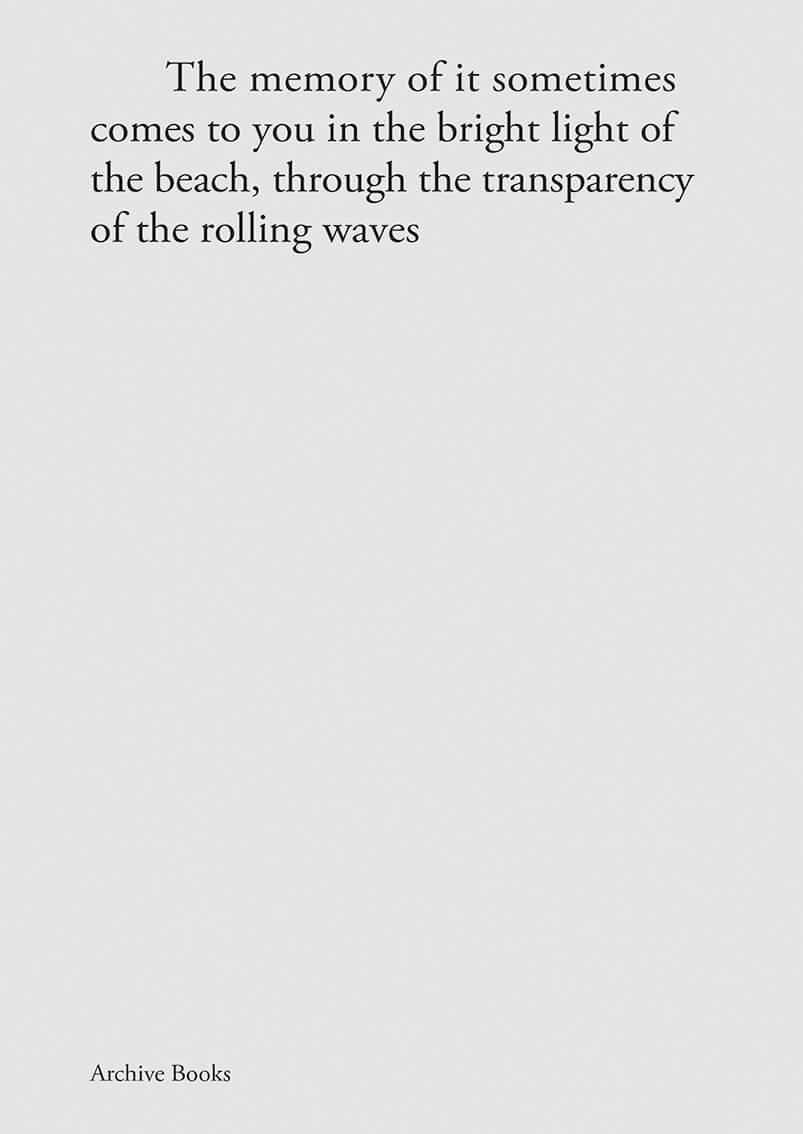
Encircling the Image of Trauma
This book tiptoes between aesthetics and ethics; it proposes to rethink trauma in its necessity as well as impossibility to be represented and understood.
The traumatic experience of violence marks social orders and imbues history. How does it reach beyond distress and pain? This collection of works interrogates alternative narratives: The traces of trauma may also comprise a subversive potential, which withdraws from the hold of power and instead makes room for a sense of history's vulnerability.
Thoughts, artistic contributions and text, most of them produced especially for this volume, move around notions of trauma, in an attempt to encircle moments, at which translation of meaning seems suddenly suspended.
Contributions by Pavel Büchler, Anca Benera & Arnold Estefan, Wendelien van Oldenborgh, Jenny Edkins, Aurélien Gamboni & Sandrine Teixido, Unica Zürn, Falke Pisano, Katja Mater, Georges Perec, Andrea Bellu, Ben Seymour, Natascha Sadr Haghighian, Gitte Villesen.
Published with Centre d'Art Contemporain Genève.
published in March 2020
English edition
13 x 20 cm (softcover)
240 pages (ill.)

exit ambition
Exit Ambition is a catalogue of practices, documents, videos, and other projects - virtual & actual. The book operates as an incomplete index of a series of installations, instructions, anti-plays, performance scores, descriptions, etc.
Jake Reber lives and works in Buffalo, NY, where he co-curates hystericallyreal.com.

COMFORT 7/32/00
The title COMFORT 7/32/00 refers to a note I found on the street one day, that became a portal into a state of mind or a particular time, although the time was out of date or imagined, foating in between past, present and future. The book is a journey through this imagined place, where vision oscillates between perception and mechanics, where objects and materials are in permanent state of melting or intersecting.
Published August 2020.

(yet)
A collection of short poetry; (yet) is journey through everything in between; transit zones, temporary shelters, weightlessness and virtual spaces.
"I came here with the illusion it could be an island, a place I could retreat to, where I could forget myself and cover all the holes from potential air infiltration. And for a while it was possible to look at the world through a plastic sheet, but it became either suffocating or the plastic was too thin. As if shutting myself off from the world made me want to look at it even more."
Published August 2020
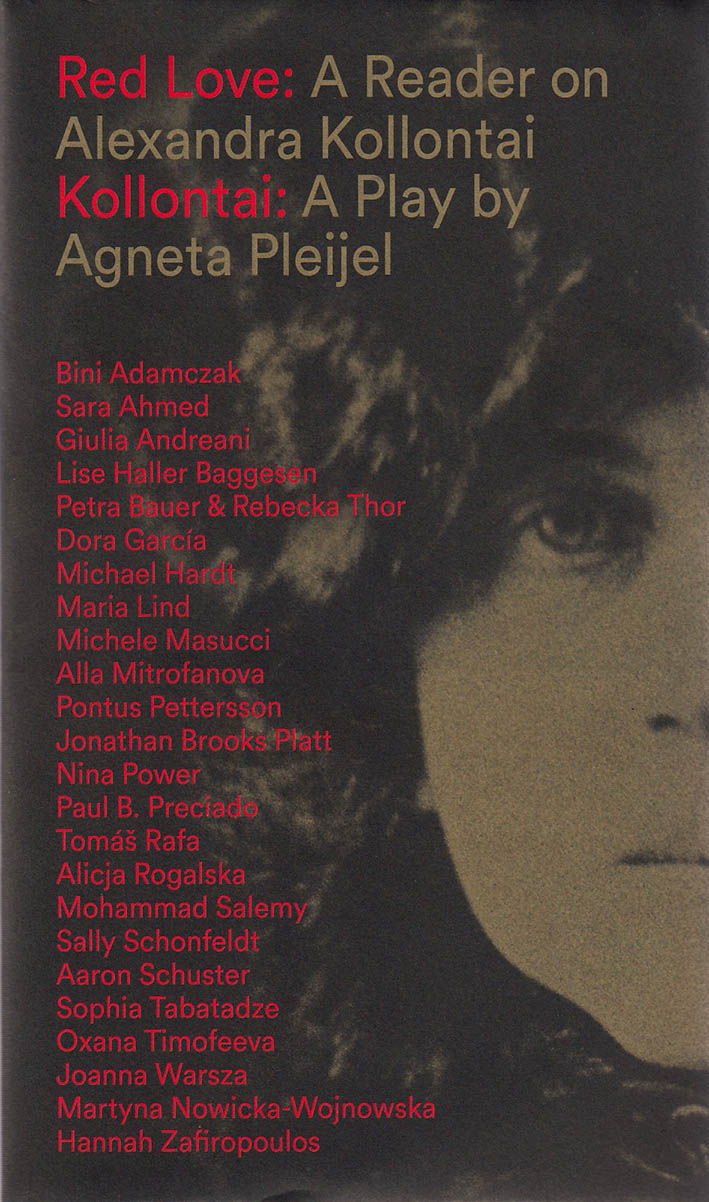
Red Love: A Reader on Alexandra Kollontai / Kollantai: A Play by Agneta Pleijel
Joanna Warsza, Michele Massucci and 1 more
Alexandra Kollontai was a Russian revolutionary who was appointed commissar of social welfare after the October Revolution and later one of the world’s first woman ambassadors. She fought for abortion rights, secularized marriage, and paid maternity leave—and considered “comradely love” to be a political force. This reader, in which artists and thinkers revisit Kollontai’s legacy in light of current feminist struggles, stems from a research project by CuratorLab at Konstfack and Tensta konsthall that accompanied Dora García’s exhibition “Red Love.” It also features the first English translation of the 1977 biographical play Kollontai by Swedish writer Agneta Pleijel.
Edited by MARIA LIND, MICHELE MASUCCI, JOANNA WARSZA
Contributions by BINI ADAMCZAK, SARA AHMED, GIULIA ANDREANI, LISE HALLER BAGGESEN, DORA GARCÍA, MICHAEL HARDT, MARIA LIND, MICHELE MASUCCI, ALLA MITROFANOVA, MARTYNA NOWICKA-WOJNOWSKA, PONTUS PETTERSSON, JONATHAN BROOKS PLATT, AGNETA PLEIJEL, NINA POWER, PAUL B. PRECIADO, THOMAS RAFA, ALICJA ROGALSKA, MOHAMMAD SALEMY, SALLY SCHONFELDT, AARON SCHUSTER, SOPHIA TABATADZE, PETRA BAUER & REBECKA THOR, OXANA TIMOFEEVA, JOANNA WARSZA, HANNAH ZAFIROPOULOS

The Annotated Reader
Jonathan P. Watts, Ryan Gander
The Annotated Reader is a publication-as-exhibition and exhibition-as-publication featuring 281 creative personalities responses and remarks on a chosen piece of writing.
Ryan Gander and Jonathan P. Watts invited a range of people, encompassing contemporary artists, designers, writers, institutional founders, musicians and so on – to imagine they’ve missed the last train.
“Is there one piece of writing that you would want with you for company in the small hours?” With this in mind, we asked people to submit a text with personal annotations and notes made directly onto it.
With over 281 contributions collected over the last few months, we have gathered a selection of contributors including Marina Abramović, Art & Language, Paul Clinton, Tom Godfrey, Ragnar Kjartansson, Sarah Lucas, Alistair Hudson and Hans Ulrich Obrist. The annotation adds a further layer, making each piece unique and a historic record of our current times.
Contributors:
Julian Abraham, Marina Abramović, Larry Achiampong, Saâdane Afif, Aaron Angell, Spencer, Anthony, Rachel Ara, Uri Aran, Cory Arcangel, Ellie Armon, Art & Language (Michael Baldwin, Mel Ramsden), François Aubart, Mary Aurory, Giles Bailey, Dan Baldwin, Fiona Banner, Simeon, Barclay, Anna Barham, Alvaro Barrington, Vanessa Bartlett, David Batchelor, Jacqueline Bebb, James Beckett, Frank Benson, Hans Berg, Emilia Bergmark, Vanessa Billy, Harry Bix, Juliette Blightman, John Bloomfield, John Bock, Doug Bowen, Benjamin Brett, Jack Brindley, Jim Broadbent, Yoko Brown, Hannah Brown, Stefan Brüggemann, Savinder Bual, Pavel Büchler, Nathaniel Budzinski, Gregory Burke, Wayne Burrows, Nikita Yingqian Cai, Mira Calix, Helen Cammock, Banu Cennetoglu, Tony Chambers, Rachael Champion, Alice Channer, Lou Cantor, Adam Chodzko, Perienne Christian, Martin Clark, Kaavous Clayton, Paul Clinton, Lucy Clout, William Cobbing, Gary Colclough, Beth Collar, Jack Cooke, May Cornet, Cel Crabeels, Paul Crook, Rob Crosse, Abraham Cruzvillegas, Francois Curlet, Matt Darbyshire, Matthew de Kersaint Giraudeau, Gabriele De Santis, Poppy De Villeneuve, Richard Deacon, Liu Ding, Stevie Dix, Nathalie Djurberg, Gabor Domokos, Lauren Doughty, Helen Dowling, Joe Dunthorne, Sam Durant, Daniel Eatock, Shannon Ebner, Sean Edwards, George Eksts, Olafur Eliasson, gerlach en koop, Vivo Enky, Gareth Evans, Alice Andrea Ewing, Sam Falls, Abbe Faria, Chantal Faust, Jes Fernie, Spencer Finch, Alice Fisher, Chris Fite-Wassilak, Sal Fontaine, Tim Foxon, Mary Furniss, Ryan Gander, Mark Geffriaud, Alessandra Genualdo, Amir George, Alexie Glass-Kantor, Patrick Goddard, Tom Godfrey, Antony Gormley, Agatha Gothe-Snape, Rodney Graham, Lavinia Greenlaw, Hannah Gregory, Joseph Grigely, Corey Hayman, Richard Hayward, Louise Hayward, Louis Henderson, Holly Hendry, Camille Henrot, Susan Hiller, Andy Holden, Ashley Holmes, David Horvitz, Alistair Hudson, Craig Hudson, Candice Jacobs, Glen Jamieson, Tess Jaray, Appau Jnr Boakye-Yiadom, Sophie Jung, John Kaldor, Allison Katz, Jasleen Kaur, Jonathan Kemp, Sharon Kivland, Ragnar Kjartansson, Lorenz Klingebiel, Matthew Krishanu, Gabriel Kuri, Zak Kyes, Emily LaBarge, Suzanne Lacy, Max Lamb, Abigail Lane, Hannah Lees, Gabriel Lester, Jenny Lindblom, Hanne Lippard, Tom Lock, Sarah Lucas, Georgia Lucas, vanessa maltese, Shepherd Manyika, Céline Manz, Michael, Marriott, Rui Mateus Amaral, Midori matsui, Rebecca May Marston, Niall McClelland, Chris McCormack, Luke Mccreadie, Francis McKee, Bea McMahon, Harry Meadley, Nathaniel Mellors, Jo Melvin, Mathieu Mercier, Daisuke Miyatsu, Jonathan Monk, Jade Montserrat, Brian Moran, Franzi Mueller Schmidt, Clive Myrie, Hiroyuki Nakanishi, Shahryar Nashat, Daniel Neofetou, Kate Newby, Simon Newby, John Henry Newton, Olaf Nicolai, Helen Nisbet, Ryan Noon, Hana Noorali, Sophie Nys, Alek O, Hans Ulrich Obrist, Harold Offeh, Ahmet Ögüt, Ima-Abasi Okon, Vanessa Onwuemezi, David Osbaldeston, Kate Owens, Jonathan P. Watts, Barnie Page, Christodoulos Panayiotou, Francesco Pedraglio, Hannah Perry, Sybella Perry, Pratchaya Phinthong, Rachel Pimm, Emily Pope, Sam Porritt, Liv Preston, Paul Purgas, Tobias Rehberger, Pedro Reyes, Emily Richardson, Jacques Rogers, #Additivism Daniel Rourke, ryanna projects (Anna Gray and Ryan Wilson Paulsen), syndicate (Sacha Leopold and François Havegeer), Giorgio Sadotti, prem sahib, Anri Sala, Margaret Salmon, Lucy A. Sames, Eran Schaerf, Annelore Schneider, Barry Schwabsky, Stephen Sheehan, Amy Sherlock, Anj Smith, John Smith, Bob and Roberta Smith, Renee So, Rustan Söderling, Nedko Solakov, Sriwhana Spong, Elinor Stanley, Georgina Starr, Astrid Stavro, Amy Stephens, Michael Stevenson, Jack Strange, Alfie Strong, Jamie Sutcliffe, Maki Suzuki, Rayyane Tabet, Mika Tajima, Lynton Talbot, Sally Tallant, Anne Tallentire, Maria Taniguchi, The Floors (Luke Dux, Ryan Dux and Ashley Doodkorte), Alice Theobald, Sam Thorne, Cara Tolmie, Marie Toseland, Rosemarie Trockel, Thom Trojanowski Hobson, Simon Turnbull, Lauren Velvick, Dana Venezia, Martin Vincent, Yonatan Vinitsky, Miriam Visaczki, Frances von Hofmannsthal, John Walter, Dan Walwin, Jessica Warboys, Ossian Ward, Evie Ward, Emily Wardill, Emily Warner, Nicholas Fox Weber, Lawrence Weiner, Charlott Weise, Richard Wentworth, Pae White, Riet Wijnen, Lillian Wilkie, Holly Willats, Issy Wood, Bill Woodrow, Seymour Wright, Shen Xin, Samson Young, Bruno Zhu, Andrea Luka Zimmerman, Andrea Zucchini, Heidi Zuckerman

Where Are the Tiny Revolts?
Anthony Huberman, Jeanne Gerrity
Where are the tiny revolts? is the first book in a new annual series published by CCA Wattis Institute, a contemporary art center and research institute in San Francisco. Each book in the series is driven by a central question: what are we learning from artists today? Unconnected to an exhibition program, Where are the tiny revolts? is rooted in the Wattis's artist-driven research institute. It is a place to explore and share some of the texts and visual work that emerge over the course of an entire year of discussions and public programs. Instead of providing documentation of projects with artists, Where are the tiny revolts? offers other ideas, voices, and references generated by conversations with and about artists.
The first book in the series, informed by themes related to the work of Dodie Bellamy, revolves around questions related to contemporary forms of feminism and sexualities, the rebirth of the author, and ways in which vulnerability, perversion, vulgarity, and self-exposure can be forms of empowerment. The texts cover a broad array of styles, including memoir, theoretical essay, art historical analysis, poetry, and fiction. The visual elements are equally diverse, ranging from photographs to collage to drawing.
Texts by Sara Ahmed, Nicole Archer, Georges Bataille, Dodie Bellamy, Michele Carlson, Thomas Clerc, Combahee River Collective, Bob Flanagan, Ursula K. Le Guin, Johanna Hedva, Glen Helfand, Juliana Huxtable, Alex Kitnick, Julia Kristeva, Audre Lorde, Lisa Robertson; contributions by Marcela Pardo Ariza, Justin G. Binek, Kaucyila Brooke, Tammy Rae Carland, Mary Beth Edelson, Mike Kuchar, Anne McGuire, Patrick Staff, Frances Stark, Rosemarie Trockel.
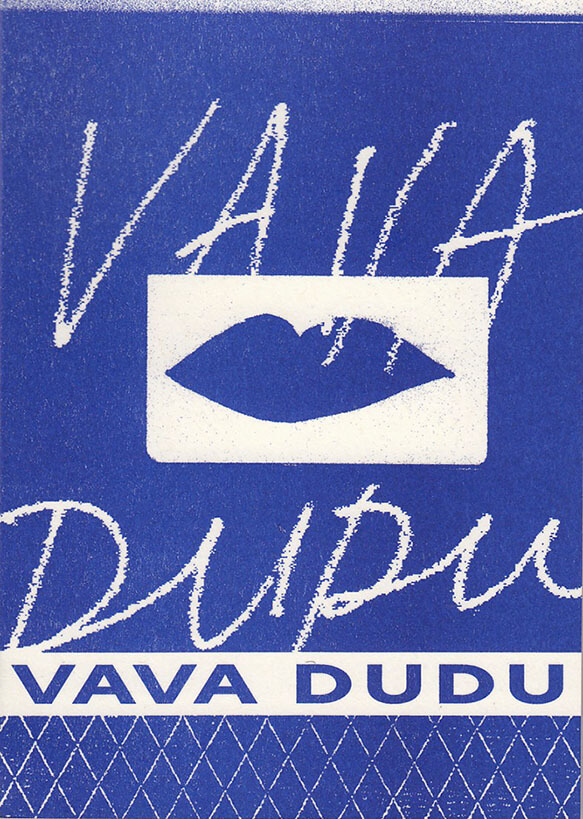
Vava Dudu
The first anthology of poetry by fashion designer, musician, painter, and Paris icon Vava Dudu. Vava’s poems are culled from language she prints and publishes on garments, as well as song lyrics from her electro-punk band La Chatte. Here her texts are translated from French to English by New York artist, musician and educator Geo Wyeth, and edited by Castilian writer and curator Alberto García del Castillo.
The book was completed in residency at the Centre for Fine Arts, Brussels (BOZAR), as part of the public program accompanying a retrospective exhibition of Keith Haring.
The edition comes in both blue and black prints.

Speech Choke
Speech Choke is a collection of flash fiction written by Helena Grande. It includes letters to imaginary lovers, speculations, absurd official events, digital ghosts, social fears, anxiety, theatrical interludes, and odes to kissing. Speech Choke expresses a feeling of categorical displacement, a state of being unable to communicate verbally and reach the outside world. Speech Choke is an experiment in the interplay between desire and the failed attempts to fulfil it.
Format Paperback | 80 pages
Dimensions 125 x 190 mm
March 2020

A Piece of Work
Mixing live performance with algorithms and interfaces, A Piece of Work is the second project in Annie Dorsen’s “algorithmic theater” series. A digital Hamlet for a post-humanist age, A Piece of Work deploys a set of ingeniously designed computer algorithms to generate real-time adaptations of Shakespeare’s original play. New scenes, songs, scores and visuals emerge from an intricate web of technology. With an introduction by Dorsen, and screen-shots of the system as it runs, this book elaborates both the technological and the poetic procedures of algorithmic theater.
Annie Dorsen is a director and writer, whose works explore the intersection of algorithms and live performance.

Hotel #5
Jon Auman, Thomas Chadwick and 1 more
Established in 2016, Hotel is a magazine for new approaches to fiction, non fiction & poetry. Hotel features work from established & emerging talent.Hotel provides the space for experimental reflection on literature’s status as art & cultural mediator.

Detour/Détours (Hotel Cordel No. 1)
Cécile Menon, Dominic Jaeckle and 1 more
Detour/Détours imagines debt as a language game: as a broken pun; a break in a journey; a play on value and the meaning of money as it changes hands. Or in terms of Guy Debord’s détournement — as a debt reimagined through the integration of old works into something new.
The word debtor owes etymologically to the old French deteur. But — moving into English — its first appearance dates back to the early 13th century and — sounded out as dettur, dettour or detour — debt can be read as an elaboration on the mottled intimations of a detour with a little poetic license. A detour is a deviation, a digression; a play on our various senses of direction. Exploring the will, want or need to take the long way around — and seeking to bastardize and scrutinize our relationship with (and conceptualization of) a statement of debt — here we have a set of searching works that critique all our methods of repayment. Participating authors were given free rein to produce a piece of writing in response to these ideas, and the works included herein — five first English-language translations and five original texts — wind their way around the weight of the word ‘debt’ in ten attempts to reroute its meaning.
Questions of Worth by Noémi Lefebvre, translated by Natascha Lasorak and Sophie Lewis
Silent B by Lauren Elkin
A Problem of the Greek Type by Mathieu Larnaudie, translated by Adrian Nathan West
Emotional Debt/Speed of Recovery Matrix by Selma Dabbagh
Debt Night by Preti Taneja
The Pastoral Calculation by Sandra Lucbert, translated by Jessica Spivey
The Debt Collector by Jen Calleja
Unknown Soldier by Nicolas Bouyssi, translated by Amanda DeMarco
Good Relations by Joanna Walsh
Out of Debt by Thomas Clerc, translated by Jeffrey Zuckerman
Edited by Emmanuel Bouju, Dominic Jaeckle & Cécile Menon
Limited Edition of 300 copies
180 x 120, paperback, 78 pages

Agatha Bauer
Maru Mushtrieva, Romy Kießling and 1 more
The title of publication series ‘Agathe Bauer’ stands for a broadly misheard hook “I’ve got the power” from a German 1990 Eurodance hit ‘The Power’ by the band Snap! The hook that turned the song into a hit, came from Jocelyn Brown’s track ‘Love's Gonna Get You’, but neither her name nor the track appears in the credits. And, here is where Agathe Bauer comes in - a mysterious being who acquires agency through the homophonic misinterpretation of the main hook “I’ve got the power”.
In ‘Issue Zero: Picking Up Promises’ Agathe has an agenda. Nothing could be as it would have been, but she is here to trace the sources of how it has become. Agathe Bauer is here to analyze the capacity of misinterpretation to unveil asymmetric power structures in knowledge systems and by tuning into the social-political, cultural and aesthetic dimension of it.
‘Issue Zero: Picking Up Promises’ features contributions by: Gabriela Acha, [{“CIBELLE”(CAVALLI}BASTOS)], Lynn Hershman Leeson, Romy Kießling, Markues, Luzie Meyer, Maru Mushtrieva, Claudia Pagès, Ruth Wolf-Rehfeldt, Miriam Stoney, Christine Sun Kim, Eric Winkler, Miriam Yammad, Anna Zett.
Conceptualized and edited by Gabriela Acha, Romy Kießling, Maru Mushtrieva.
Designed by Timur Akhmetov.